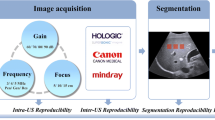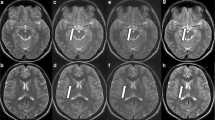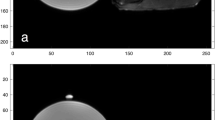Abstract
Objectives
To investigate the impact of acceleration factors on reproducibility of radiomic features in sensitivity encoding (SENSE) and compressed SENSE (CS), compare between SENSE and CS, and identify reproducible radiomic features.
Methods
Three-dimensional turbo spin echo T1-weighted imaging was performed in 14 healthy volunteers (mean age, 57 years; range, 33–67 years; 7 men) under SENSE and CS with accelerator factors of 5.5, 6.8, and 9.7. Eight anatomical locations (brain parenchyma, salivary glands, masseter muscle, tongue, pharyngeal mucosal space, eyeballs) were evaluated. Reproducibility of radiomic features was evaluated by calculating concordance correlation coefficient (CCC) in reference to the original image (SENSE with acceleration factor of 3.5). Reproducibility of radiomic features among acceleration factors and between SENSE and CS was compared.
Results
Proportion of radiomic features with CCC > 0.85 in reference to the original image was lower with higher acceleration factors in both SENSE and CS across all anatomical locations (p < .001). Proportion of radiomic features with CCC > 0.85 in reference to the original image was higher in SENSE compared with CS (SENSE, 6.7–7.3% vs CS, 4.4–5.0%; p < .001). Run percentage of gray-level run-length matrix (GLRLM) with wavelet D showed CCC > 0.85 in reference to the original image in both SENSE and CS at acceleration factor of 9.7 in the highest number of anatomical locations.
Conclusions
Higher acceleration factors resulted in lower reproducibility of radiomic features in both SENSE and CS, and SENSE showed higher reproducibility of radiomic features than CS in reference to the original image. Run percentage of GLRLM with wavelet D was identified as the most reproducible feature.
Key Points
• Reproducibility of radiomic features in reference to the original image was lower with higher acceleration factors in both sensitivity encoding (SENSE) and compressed SENSE (CS) across all anatomical locations (p < .001).
• SENSE showed higher proportions of radiomic features with CCC > 0.85 in reference to the original image (SENSE, 6.7–7.3% vs CS, 4.4–5.0%; p < .001) compared with CS.
• Run percentage of gray-level run-length matrix (GLRLM) with wavelet D showed CCC > 0.85 in reference to the original image in both SENSE and CS with the highest acceleration factor.






Similar content being viewed by others
Abbreviations
- AFt :
-
Acceleration factor
- CCC:
-
Concordance correlation coefficient
- CS:
-
Compressed sensing combined with SENSE
- GLCM:
-
Gray-level co-occurrence matrix
- GLRLM:
-
Gray-level run-length matrix
- IQR:
-
Interquartile range
- ROI:
-
Region of interest
- SENSE:
-
Sensitivity encoding
- T1WI:
-
T1-weighted imaging
References
Lustig M, Donoho D, Pauly JM (2007) Sparse MRI: the application of compressed sensing for rapid MR imaging. Magn Reson Med 58:1182–1195
Yang AC, Kretzler M, Sudarski S, Gulani V, Seiberlich N (2016) Sparse reconstruction techniques in magnetic resonance imaging: methods, applications, and challenges to clinical adoption. Invest Radiol 51:349–364
Jaspan ON, Fleysher R, Lipton ML (2015) Compressed sensing MRI: a review of the clinical literature. Br J Radiol 88:20150487
Toledano-Massiah S, Sayadi A, de Boer R et al (2018) Accuracy of the compressed sensing accelerated 3D-FLAIR sequence for the detection of MS plaques at 3T. AJNR Am J Neuroradiol https://doi.org/10.3174/ajnr.A5517
Suh CH, Jung SC, Lee HB, Cho SJ (2019) High-resolution magnetic resonance imaging using compressed sensing for intracranial and extracranial arteries: comparison with conventional parallel imaging. Korean J Radiol 20:487–497
Cho SJ, Choi YJ, Chung SR, Lee JH, Baek JH (2019) High-resolution MRI using compressed sensing-sensitivity encoding (CS-SENSE) for patients with suspected neurovascular compression syndrome: comparison with the conventional SENSE parallel acquisition technique. Clin Radiol 74:817.e819–817.e814
Chandarana H, Feng L, Block TK et al (2013) Free-breathing contrast-enhanced multiphase MRI of the liver using a combination of compressed sensing, parallel imaging, and golden-angle radial sampling. Invest Radiol 48:10–16
Otazo R, Kim D, Axel L, Sodickson DK (2010) Combination of compressed sensing and parallel imaging for highly accelerated first-pass cardiac perfusion MRI. Magn Reson Med 64:767–776
Zhu C, Tian B, Chen L et al (2018) Accelerated whole brain intracranial vessel wall imaging using black blood fast spin echo with compressed sensing (CS-SPACE). MAGMA 31:457–467
Vranic JE, Cross NM, Wang Y, Hippe DS, de Weerdt E, Mossa-Basha M (2019) Compressed Sensing-Sensitivity Encoding (CS-SENSE) accelerated brain imaging: reduced scan time without reduced image quality. AJNR Am J Neuroradiol 40:92–98
Gillies RJ, Kinahan PE, Hricak H (2016) Radiomics: images are more than pictures, they are data. Radiology 278:563–577
Lambin P, Rios-Velazquez E, Leijenaar R et al (2012) Radiomics: extracting more information from medical images using advanced feature analysis. Eur J Cancer 48:441–446
Balagurunathan Y, Kumar V, Gu Y et al (2014) Test-retest reproducibility analysis of lung CT image features. J Digit Imaging 27:805–823
Berenguer R, Pastor-Juan MDR, Canales-Vázquez J et al (2018) Radiomics of CT features may be nonreproducible and redundant: influence of CT acquisition parameters. Radiology 288:407–415
Meyer M, Ronald J, Vernuccio F et al (2019) Reproducibility of CT radiomic features within the same patient: influence of radiation dose and CT reconstruction settings. Radiology 293:583–591
Park BW, Kim JK, Heo C, Park KJ (2020) Reliability of CT radiomic features reflecting tumour heterogeneity according to image quality and image processing parameters. Sci Rep 10:3852
O’Connor JP, Aboagye EO, Adams JE et al (2017) Imaging biomarker roadmap for cancer studies. Nat Rev Clin Oncol 14:169–186
Park JE, Park SY, Kim HJ, Kim HS (2019) Reproducibility and generalizability in radiomics modeling: possible strategies in radiologic and statistical perspectives. Korean J Radiol 20:1124–1137
Nolden M, Zelzer S, Seitel A et al (2013) The Medical Imaging Interaction Toolkit: challenges and advances : 10 years of open-source development. Int J Comput Assist Radiol Surg 8:607–620
Kickingereder P, Burth S, Wick A et al (2016) Radiomic profiling of glioblastoma: identifying an imaging predictor of patient survival with improved performance over established clinical and radiologic risk models. Radiology 280:880–889
Kang D, Park JE, Kim YH et al (2018) Diffusion radiomics as a diagnostic model for atypical manifestation of primary central nervous system lymphoma: development and multicenter external validation. Neuro Oncol. https://doi.org/10.1093/neuonc/noy021
Zwanenburg A, Leger S, Vallières M, Löck S (2016) Image biomarker standardisation initiative. arXiv preprint arXiv:161207003
Lin LI (1989) A concordance correlation-coefficient to evaluate reproducibility. Biometrics 45:255–268
Liang D, Liu B, Wang J, Ying L (2009) Accelerating SENSE using compressed sensing. Magn Reson Med 62:1574–1584
Smith DS, Li X, Abramson RG, Quarles CC, Yankeelov TE, Welch EB (2013) Potential of compressed sensing in quantitative MR imaging of cancer. Cancer Imaging 13:633–644
Galloway MM (1975) Texture analysis using gray level run lengths. Comput Graph Image Process 4:172–179
Orlhac F, Soussan M, Maisonobe JA, Garcia CA, Vanderlinden B, Buvat I (2014) Tumor texture analysis in 18F-FDG PET: relationships between texture parameters, histogram indices, standardized uptake values, metabolic volumes, and total lesion glycolysis. J Nucl Med 55:414–422
Parmar C, Rios Velazquez E, Leijenaar R et al (2014) Robust radiomics feature quantification using semiautomatic volumetric segmentation. PLoS One 9:e102107
Traverso A, Wee L, Dekker A, Gillies R (2018) Repeatability and reproducibility of radiomic features: a systematic review. Int J Radiat Oncol Biol Phys 102:1143–1158
Ford J, Dogan N, Young L, Yang F (2018) Quantitative radiomics: impact of pulse sequence parameter selection on MRI-based textural features of the brain. Contrast Media Mol Imaging 2018:1729071
Cho SJ, Jung SC, Suh CH, Lee JB, Kim D (2019) High-resolution magnetic resonance imaging of intracranial vessel walls: comparison of 3D T1-weighted turbo spin echo with or without DANTE or iMSDE. PLoS One 14:e0220603
Acknowledgements
The same cohort (all 14 healthy volunteers enrolled in the Acceleration Technique registry) was previously reported in a study evaluating image quality in SENSE and CS qualitatively by visual scoring systems and quantitatively by measurement of signal-to-noise ratio and contrast-to-noise ratio [5] while the current study investigated reproducibility of radiomic features in SENSE and CS. The same cohort was also reported in a study comparing 3D T1-weighted turbo spin echo with or without delay alternating with nutation for tailored excitation and improved motion-sensitized driven equilibrium [31].
Funding
This study was supported by the National Research Foundation of Korea (NRF) grant funded by the Korea government (2019R1A2C1089939).
Author information
Authors and Affiliations
Corresponding author
Ethics declarations
Guarantor
The scientific guarantor of this publication is Seung Chai Jung.
Conflict of interest
The authors of this manuscript declare no relationships with any companies whose products or services may be related to the subject matter of the article.
Statistics and biometry
Dr. Seo Young Park kindly provided statistical advice for this manuscript.
Informed consent
Written informed consent was obtained from all subjects (patients) in this study.
Ethical approval
Institutional Review Board approval was obtained.
Study subjects or cohorts overlap
The same cohort (all 14 healthy volunteers enrolled in the Acceleration Technique registry) was previously reported in a study evaluating image quality in SENSE and CS qualitatively by visual scoring systems and quantitatively by measurement of signal-to-noise ratio and contrast-to-noise ratio [1] while the current study investigated reproducibility of radiomic features in SENSE and CS. The same cohort was also reported in a study comparing 3D T1-weighted turbo spin echo with or without delay alternating with nutation for tailored excitation and improved motion-sensitized driven equilibrium [2].
1 Suh CH, Jung SC, Lee HB, Cho SJ (2019) High-Resolution Magnetic Resonance Imaging Using Compressed Sensing for Intracranial and Extracranial Arteries: Comparison with Conventional Parallel Imaging. Korean journal of radiology 20:487-497
2 Cho SJ, Jung SC, Suh CH, Lee JB, Kim D (2019) High-resolution magnetic resonance imaging of intracranial vessel walls: Comparison of 3D T1-weighted turbo spin echo with or without DANTE or iMSDE. PLoS One 14:e0220603
Methodology
• retrospective
• observational
• performed at one institution
Additional information
Publisher’s note
Springer Nature remains neutral with regard to jurisdictional claims in published maps and institutional affiliations.
Supplementary Information
ESM 1
(DOCX 2515 kb)
Rights and permissions
About this article
Cite this article
Kim, M., Jung, S.C., Park, J.E. et al. Reproducibility of radiomic features in SENSE and compressed SENSE: impact of acceleration factors. Eur Radiol 31, 6457–6470 (2021). https://doi.org/10.1007/s00330-021-07760-w
Received:
Revised:
Accepted:
Published:
Issue Date:
DOI: https://doi.org/10.1007/s00330-021-07760-w




